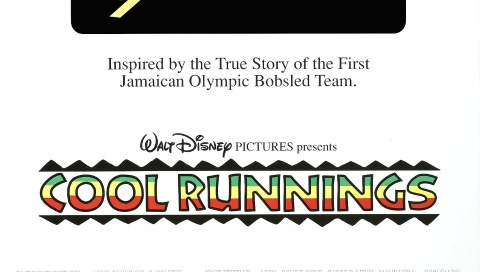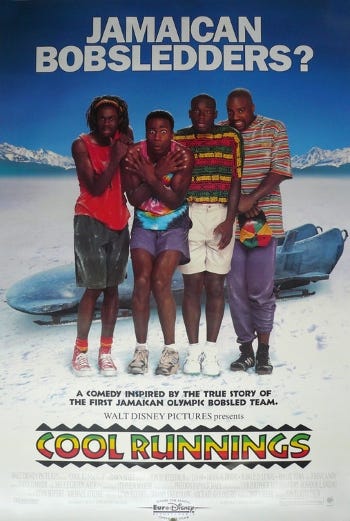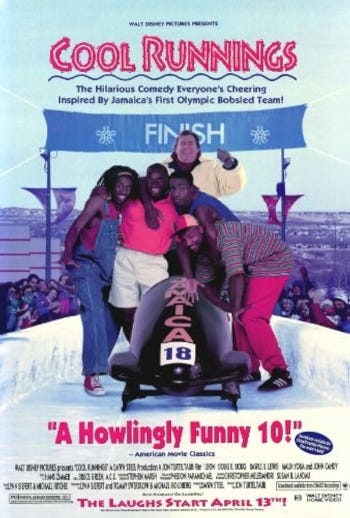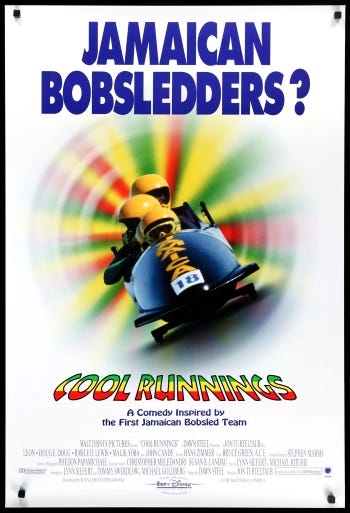Disney Plus-Or-Minus: Cool Runnings
After the release of Splash in 1984, multiple outlets reported that John Candy had signed a three-picture development deal with Disney. Curiously, nothing ever seemed to result from it. Candy made a lot of movies in the 1980s, frequently in collaboration with writer-producer-director John Hughes, but none of them were for Disney. When he did finally return to the studio, it was to provide the voice of Wilbur the albatross in the 1990 sequel The Rescuers Down Under.
Not that there hadn’t been opportunities along the way. Candy had been offered the lead in Honey, I Shrunk The Kids. He didn’t think he was a good fit for the role and instead recommended his old SCTV friend Rick Moranis. He’d also been considered for the role of Bette Midler’s husband in Touchstone’s Stella. But Midler’s insistence that he undergo a screen test infuriated him so much that he took himself out of contention.
On its surface, Cool Runnings, loosely based on the true story of the first Jamaican Olympic Bobsled Team, might not seem like an obvious candidate for a John Candy vehicle. Indeed, if the movie had been made a year or so earlier like it was supposed to, it very likely wouldn’t have featured Candy at all. But it turned out to be a sleeper hit, a welcome change after a string of duds like Delirious and Once Upon A Crime. Sadly, it also turned into something of a swan song.
The project was originally headed in a much different direction, as a serious dramatic sports film under the title Blue Maaga. It was first set up at Tri-Star Pictures, a division of Columbia then under the leadership of Dawn Steel. Tri-Star and the original creative team (which included Michael Ritchie, whose work on The Bad News Bears proved he knew a thing or two about underdog sports movies) fell out of love with the project relatively quickly. So, when Steel decamped from Columbia to set up her own independent production shingle at Disney, she took Blue Maaga with her.
Once at Disney, Steel continued developing the project along those same lines. Tommy Swerdlow and Michael Goldberg were brought on board to rewrite Lynn Seifert’s script. Directors, including Jeremiah S. Chechik and Brian Gibson (both of whom will eventually appear on either the Disney or Touchstone sides of this column), came and went. And searches began to find the actors who would play the athletes and their coach.
A long list of actors was considered to play the four bobsledders. Eventually, Leon (then probably best known for his appearance in Madonna’s controversial “Like A Prayer” music video) was cast as team leader Derice Bannock. Stand-up comedian Doug E. Doug was cast as pushcart derby champ Sanka Coffie. Malik Yoba, who would go on to build an extensive career in film and television, got one of his first big roles as Yul Brenner, the ultra-competitive tough guy who joins the team in a last ditch attempt at going to the Olympics. Rawle D. Lewis got an even bigger break when he was cast as rich kid Junior Bevil, whose mistake during the 100-meter dash trials inadvertently kicks things off. Lewis wasn’t even supposed to audition. He’d been hired by the casting office to read lines opposite the “real” actors. But his presence began to win over the casting director, who eventually offered him a screen test, much to Lewis’s surprise.
The four teammates had been officially cast and the project seemed to be heading into production when Disney began to have second thoughts. There were lingering script concerns and the budget appeared to be much too high for such a low-wattage movie. They sent the production team back to the drawing board. As a result, Brian Gibson, the most recent director, opted to bow out to focus on other projects.
To replace Gibson, Disney tapped Jon Turteltaub, whose low-budget 3 Ninjas had just been a massive success for Touchstone. At the same time, the studio secured Turteltaub’s services for two additional movies. Turteltaub would go on to become one of Disney’s most consistent directors. What directors like Norman Tokar were to the studio in the ‘60s and ‘70s, Turteltaub was to the ‘90s.
Throughout all this, no one had quite settled on who should play the coach, former Olympic gold medalist Irv Blitzer. Lots of names were bandied about, including former Disney star Kurt Russell (he’d have to wait a few more years to make his Olympic dreams come true at the studio). But when the script caught the attention of John Candy, he fell in love with the role, even offering to take a pay cut to get it. The addition of Candy gave Turteltaub and the writers the liberty they needed to lean into the story’s comedic elements. The story may be inspirational but there is something inherently funny about the idea of a Jamaican bobsled team. There were already elements of that at play but the casting of John Candy gave them the push needed to bring it to the fore.
Candy turned out to be exactly what the picture was missing. John Candy excelled at playing lovable everyman underdogs with a wry, mischievous sense of humor. Irv Blitzer fits squarely within his wheelhouse. He’s a believable and inspirational coach, pulling his team together despite the odds. And who better than a Canadian like him to introduce four young Jamaican guys to a world of bitter cold and snow? Candy’s performance doesn’t exactly make the movie but it would certainly be a poorer one without it.
The movie would, however, entirely fall apart if you didn’t become invested in the formation of the team. Leon, Doug, Lewis and Yoba were ideally cast, four disparate personalities whose initial friction ultimately gives way to camaraderie. The four guys had to cool their heels for about a year while the movie was rethought and it’s a minor miracle that they didn’t lose one or two along the way. These four actors blend together so well, it’s easy to believe in their characters and their dreams of glory.
Perhaps needless to say, Cool Runnings took a whole lot of liberties with the true story that inspired it. Everything from names to details to events were changed, reimagined and omitted in the name of making a more entertaining picture. I don’t want to get bogged down in the minutiae of fact versus fiction. There are plenty of places online you can look it up if you’re so inclined. One fight worth mentioning is a note Turteltaub received from the studio regarding the characters’ accents. Turteltaub was striving for realism but the studio feared no one would be able to understand real Jamaican accents. The director argued his case as best he could but soon realized this was a fight he was going to lose. Turteltaub reportedly returned to set and informed his cast, “Disney wants you to sound like Sebastian the crab or you’re all fired.” The message was received and the actors switched to a cartoonier, more sing-song parody of Jamaica.
As the movie’s October 1, 1993, release date neared, Disney still didn’t have a great deal of confidence in the picture and didn’t put much effort into marketing it. Still, it opened in a respectable third place (behind Malice and The Good Son) with over $7 million. After positive word of mouth began to spread, the movie actually went up in its second week, landing in second with over $8.5 million. Most critics enjoyed the movie (Siskel and Ebert being two notable holdouts) and it continued performing well throughout the fall. It became the fifteenth highest-grossing movie of 1993, sandwiched between Grumpy Old Men and Dave, with a grand total of nearly $69 million.
For John Candy, this would be one of his final victory laps. After Cool Runnings, he signed on to star in Canadian Bacon, the first (and, so far, only) non-documentary feature directed by Michael Moore. Once that had wrapped, he traveled down to Mexico to shoot the comedy-western Wagons East alongside comedian Richard Lewis. While on location, he suffered a fatal heart attack, passing away at the age of 43. Cool Runnings would be the last movie released during his lifetime, sparing him from seeing the negative reactions to his last two pictures.
Cool Runnings also opened up a brand new door for Disney. Previously, whenever the studio had depicted sports on film, there was usually a healthy supply of Flubber or a supercomputer or a voodoo curse or two around to keep things lively. Cool Runnings suggested that real life could be just as entertaining and successful. Over the next decade or so, the studio would return again and again to the inspirational sports formula and this column will cover them all. We’ll see football, baseball, hockey, golf, basketball. There’s probably a sport or two the studio hasn’t touched yet but give ‘em time. I’m sure there’s an inspirational pickleball movie out there waiting to get made.
The enduring popularity of Cool Runnings boils down to chemistry. The Jamaican Bobsled Team was a fun story when it made the news in 1988 but its success as a feature film was by no means guaranteed. Without Leon, Doug E. Doug, Rawle D. Lewis, Malik Yoba and the late, great John Candy, this could easily have been a quickly forgotten TV-movie. But with them, it’s a genuinely fun and memorable movie that has insured the Jamaican Bobsled Team won’t be forgotten, despite the liberties taken with the truth. It’s a textbook example of the old Liberty Valance adage: print the legend.
VERDICT: Disney Plus







